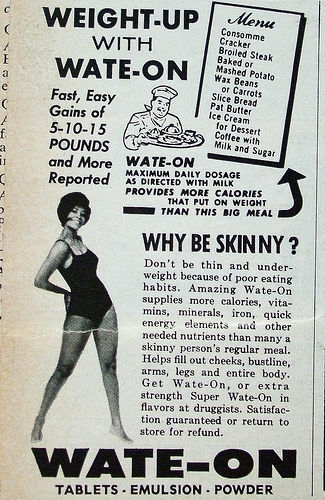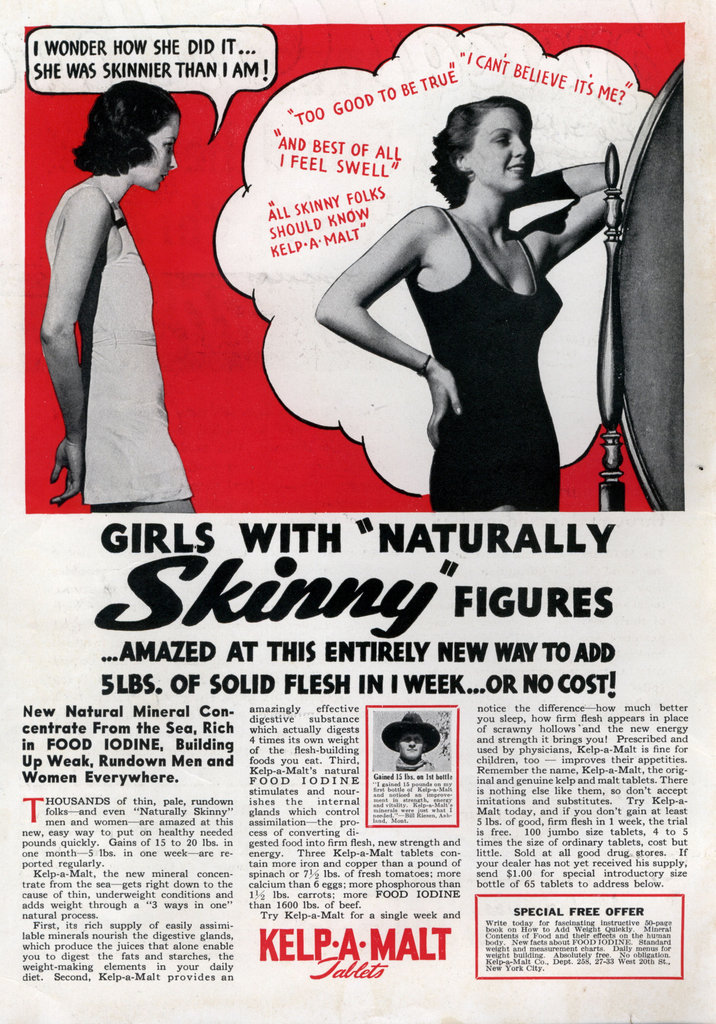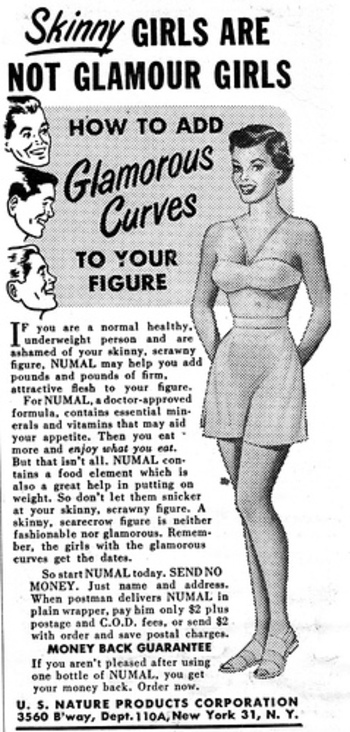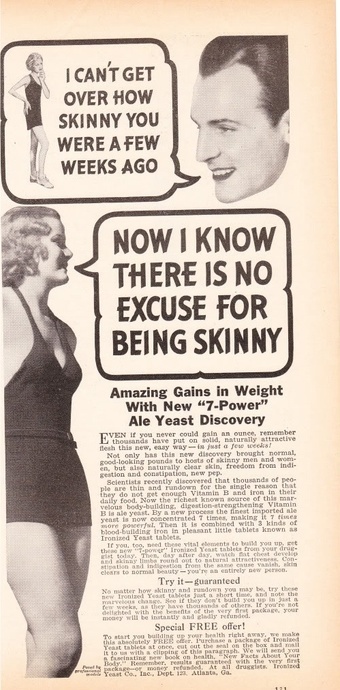A couple of years ago we posted a series of weight gain ads from the 1940s, ’50s, and ’60s. Yes, weight gain ads. Say it a few times, see how it rolls unfamiliarly around your tongue. If you consume popular culture, it’s rare to come across anyone suggesting that there’s such a thing as women who are too skinny. Quite the opposite. Yet, during the middle decades of the 1900s, being too skinny was a problem that women worried about. And Wate-On was there to help them achieve the “glamorous curves” of “popular” girls.
Jeremiah gave us a great excuse to re-post this already-posted material. He sent in an ad for Wate-On featuring Raquel Welch:

There are interesting conversations to be had here. Is pressure to be full-figured any different than pressure to be thin? It’s just another kind of pressure to conform to a particular kind of body. Is the mid-century ideal different than the contemporary ideal of “curvy” women? In other words, are these women any less thin, or any less hourglass-figured, than the supposedly curvy icons of today: Beyonce, JLo, etc? Are there any products for women who think they are too skinny today? Can we make an interesting comparison between the capitalist and the medical solution to “too skinny”? Other thoughts?
—————————
Julie C. found this ad in a newspaper from the 1960s:

The text:
“If skinny, thin and underweight take improved WATE-ON to help put on pounds and inches of firm, healthy looking flesh. WATE-ON supplies weight gaining calories plus vitamins, minerals, protein and other beneficial nutrients. Clinically tested. Fast weight gains 4, 6, 10… as much as 20 and 30 pounds have been reported. No over-eating. Helps make bustline, cheeks, arms, legs fill out, helps put firm solid flesh on skinny figures all over body. Helps fight fatigue, low resistance, sleeplessness and nervousness that so often accompany underweight. Underweight children and convalescents can take WATE-ON. It’s a clinically tested, pleasant formula sold around the world. Buy some today and start putting on weight FAST. Satisfaction from 1st bottle or price refunded. At drug stores everywhere.”
Another (year unknown, found here):

Taylor D. sent in this add for Wate-On (found here), which targets African American women:

Here’s another brand for a similar product from 1943:

Text:
Girls with “Naturally Skinny” Figures …AMAZED AT THIS ENTIRELY NEW WAY TO ADD 5 LBS. OF SOLID FLESH IN 1 WEEK…OR NO COST!
New Natural Mineral Concentrate From the Sea, Rich in FOOD IODINE, Building Up Weak, Rundown Men and Women Everywhere.
THOUSANDS of thin, pale, rundown folks–and even “Naturally Skinny” men and women–are amazed at this new, easy way to put on healthy needed pounds quickly. Gains of 15 to 20 lbs. in one month–5 lbs. in one week–are reported regularly.
Kelp-a-Malt, the new mineral concentrate from the sea–gets right down to the cause of thin, underweight conditions and adds weight through a “3 ways in one” natural process.
First, its rich supply of easily assimilable minerals nourish the digestive glands, which produce the juices that alone enable you to digest the fats and starches, the weight-making elements in your daily diet. Second, Kelp-a-Malt provides an amazingly effective digestive substance which actually digests 4 times its own weight of the flesh-building foods you eat. Third, Kelp-a-Malt’s natural FOOD IODINE stimulates and nourishes the internal glands which control assimilation–the process of converting digested food into firm flesh, new strength and energy. Three Kelp-a-Malt tablets contain more iron and copper than a pound of spinach or 7-1/2 lbs. of fresh tomatoes; more calcium than 6 eggs; more phosphorous than 1-1/2 lbs. carrots; more FOOD IODINE than 1600 lbs. of beef.
Try Kelp-a-Malt for a single week and notice the difference–how much better you sleep, how firm flesh appears in place of scrawny hollows” and the new energy and strength it brings you! Prescribed and used by physicians, Kelp-a-Malt is fine for children, too–improves their appetities. Remember the name, Kelp-a-Malt, the original and genuine kelp and malt tablets. There is nothing else like them, so don’t accept imitations and substitutes. Try Kelp-a-Malt today, and if you don’t gain at least 5 lbs. of good, firm flesh in 1 week, the trial is free. 100 jumbo size tablets, 4 to 5 times the size of ordinary tablets, cost but little. Sold at all good drug, stores. If your dealer has not yet received his supply, send $1.00 for special introductory size bottle of 65 tablets to address below.
Vintage Ads posted another example:

Text:
If you are a normal healthy, underweight person and are ashamed of your skinny, scrawny figure, NUMAL may help you add pounds and pounds of firm, attractive flesh to your figure.
For NUMAL, a doctor-approved formula, contains essential minerals and vitamins that may aid your appetite. Then you eat more and enjoy what you eat. But that isn’t all. NUMAL contains a food element which is also a great help in putting on weight. So don’t let them snicker at your skinny, scrawny figure. A skinny, scarecrow figure is neither fashionable nor glamorous. Remember, the girls with the glamorous curves get the dates.
So start NUMAL today…
Lauren McGuire spotted this ad (at Vintage Ads, via Jezebel):

Lisa Wade, PhD is an Associate Professor at Tulane University. She is the author of American Hookup, a book about college sexual culture; a textbook about gender; and a forthcoming introductory text: Terrible Magnificent Sociology. You can follow her on Twitter and Instagram.














